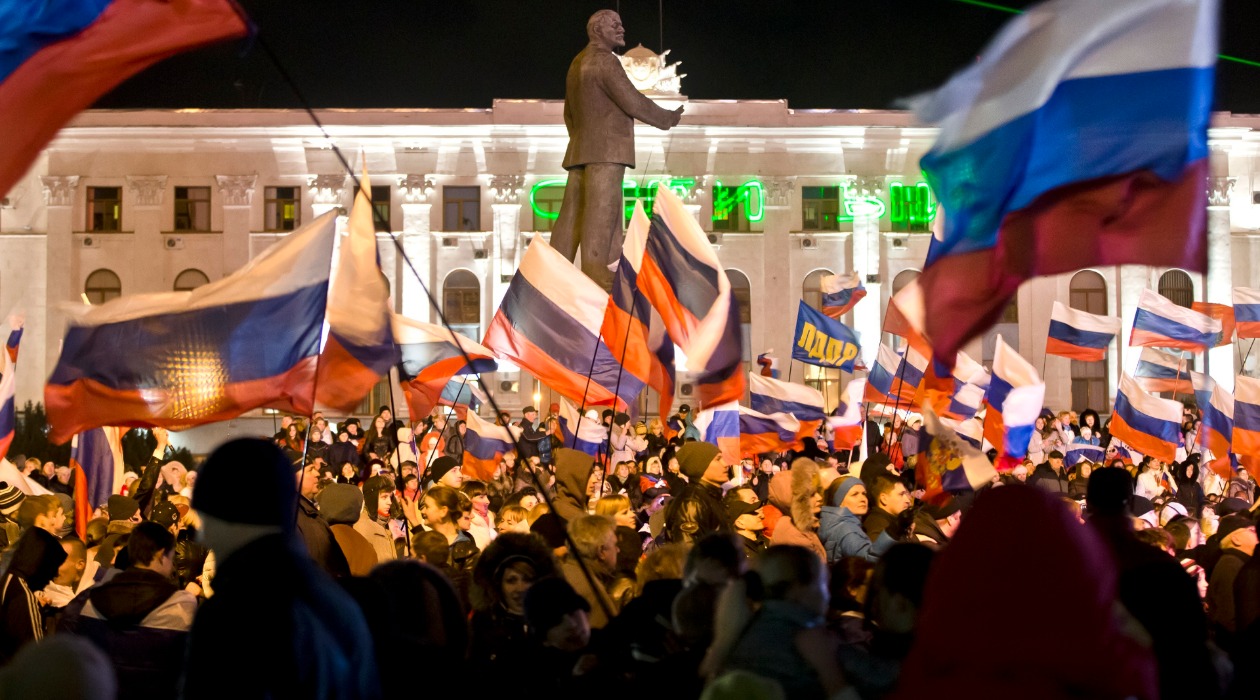
Kate Clark is the former Moscow correspondent for Britain’s Morning Star newspaper. She was stationed there from 1985-90, during the Soviet Union’s final years. As part of her work, she spent time in Crimea, whose people voted in 2014 to return to Russian administration rather than Ukrainian. With the hype around a possible Russian “invasion” of Ukraine, many commentators are now reviving stories of Russia’s “annexation” of Crimea as an example of the supposed fate that awaits Ukraine. In the following article, Clark looks at the history of Crimea and subverts the mainstream media’s tales of a Russian takeover of the region. It includes excerpts from a forthcoming book on her years in Moscow.
In June 1985, as the Morning Star’s Moscow correspondent, I had the chance to visit the Crimean peninsula, for centuries a holiday and recuperation favorite for Russian leaders and famous writers like Mikhail Lermontov, Anton Chekhov (whose famous short story The Lady with the Little Dog was set in Yalta), Leo Tolstoy (whose family lived for nearly a year in an old mansion in Gaspra), Fyodor Dostoyevsky, and many other prominent Russians of pre-revolutionary times.
Russia’s most famous 19th-century poet, Alexander Pushkin, was exiled from St. Petersburg to Crimea for his poems about freedom. And in the 20th century, Marina Tsvetaeva, Maxim Gorky, and Alexei Tolstoy all found inspiration in Crimea’s warm air and beautiful scenery.

With the current heightened levels of anti-Russian sentiment and the return of the Cold War mindset, it is important to understand the history of this region and why it sees itself as Russian.
At about the same time as the British Empire laid claim to the Falkland Islands, the Russian Empire claimed Crimea. It was the late 1770s and the time of empires when a fleet of ships could land on a place and declare it henceforth their territory.
The Falkland Islands, which the Spanish had claimed earlier and named Las Malvinas, are nearly 8,000 miles from London, off the east coast of Argentina. Crimea is nearly 800 miles from Moscow and only a few miles from the border with mainland Russia.
The Crimean Peninsula, which had previously been part of the Ottoman Empire, was annexed by the Russian Empire on April 19, 1783, during the reign of Catherine the Great. That same year, Russia began construction of a naval base and fortress, Sevastopol. Some 70 years later, there was the Crimean War, 1853-56, in which the Russian Empire lost to an alliance of the Ottoman Empire, France, Britain, and Sardinia.
The human cost of that conflict was immense: One estimate gives 25,000 British, 100,000 French, and up to a million Russians killed, almost all of disease and neglect. Florence Nightingale and Mary Seacole became heroes for their work in improving hospital conditions for the wounded.
A key battle in the Crimean War was that of Sevastopol, which was besieged by the British. Since the 1917 Russian Revolution, the city has been the home port of first the Soviet Navy’s Black Sea Fleet and then the Russian, and as such, of great strategic importance to Russia.
Following the Revolution, in the ensuing civil war, Crimea was fought over by the Bolsheviks and the Whites (counter-revolutionaries). After the Bolsheviks triumphed, in 1921 the Crimean Peninsula became part of the Russian Soviet Federative Socialist Republic.
During the civil war, Crimea was the last foothold of resistance for the White Army. Refugee ships departed from its ports carrying scientists, artists, and writers. The year 1920, which saw the Bolsheviks’ final victory, was an important milestone for Russian literature. The play Flight by Mikhail Bulgakov reflects the last days of that old Russia.
“Crimea was a sort of Noah’s Ark in distress. Here, White Army soldiers, priests, and aristocrats from St. Petersburg were trying to understand what happened to Russia and how to find their place in the world,” Aleksandra Guryanova wrote in Rossiyskaya Gazeta.

The sunny Crimean Peninsula in the Black Sea is more famous in the rest of the world for hosting the Yalta Conference in February 1945, where the heads of government of the Allies — Roosevelt, Churchill, and Stalin, of the United States, Great Britain, and the Soviet Union respectively, met to agree on how Europe would be reorganized after the Nazis’ defeat in the Second World War.
Back in 1985, I visited the Livadia Palace where that conference took place. In pre-revolutionary times, it was one of the tsar’s palaces, then a museum. I was told of Lenin’s decree, following the 1917 October Revolution, that all such palaces would henceforth belong to the workers and peasants.
Soviet partisans had saved the palace during WWII from destruction by the Nazis, who had stolen wall decorations, chandeliers, and objets d’art. “Nothing was ever returned to us,” our guide told us, “of the 800 or so precious objects they took.”
Another room held documents from the three postwar conferences—Potsdam, Tehran, and Yalta. Among the many topics discussed at Livadia was the need to de-Nazify Germany, the Soviet Union being in favor, our guide stressed, of “a strong, democratic, and unified Germany.”
Once more on this visit, as in so many others in different parts of the Soviet Union, the dreadful effects of the war were highlighted. It was like a painful scar which never completely healed. It’s estimated that the USSR lost some 26 million citizens, military and civilian. It is hard to take in the enormity of such loss, the effects caused to the economy of a generation of missing men, and the effects on the demography of the country.
As mentioned, following the Russian civil war, Crimea was part of the Russian Soviet Federative Socialist Republic, the biggest of the 15 constituent republics of the USSR. In 1954, Crimea was transferred, in an administrative decision, to the Ukrainian Soviet Socialist Republic, so that at the time of the 1991 break-up of the Soviet Union, Crimea was technically part of Ukraine.

So for 134 years, from 1783 until 1954, Crimea had belonged to Russia and for 33 years to Soviet Ukraine, which at the time of the transfer was part of the same nation—the USSR. And its people reflected that history: Crimea’s population was traditionally mainly Russian (over 60%), with Ukrainians making up 15% and Crimean Tatars 12%.
As I write now, probably one of the few things most people know about Crimea is that Russia invaded the peninsula in 2014. Yet this invasion was the most peaceful intervention ever, occurring after a referendum showing that the vast majority of Crimeans wanted to be part of Russia. In March 2014, Russia organized a plebiscite among the population of the Crimean Peninsula, the overwhelming result of which was for the peninsula to once again become part of Russia.
As Crimea is home to the Russian Navy’s Black Sea Fleet in Sevastopol, from the time when Ukraine was part of the USSR, out of strategic and security interests it is not surprising that Russia should want that base to be in a friendly territory, not where Nazi collaborators are feted and where their supporters openly march the streets.
Ukraine’s current government is pursuing a deliberately anti-Russian policy, doing its best, it seems, to undo decades of friendship and good relations between Ukrainians and Russians, whose history is intertwined from as long ago as 10th century Kiev Rus which united the Slavic peoples of these regions.
As Germany’s navy chief, Kay-Achim Schönbach, said earlier this week, in an off-the-cuff remark of realpolitik, for which he has now been forced by the warmongers of NATO to resign, Crimea should be recognized as belonging to Russia.
This is an edited version of an article that first appeared in Morning Star.









